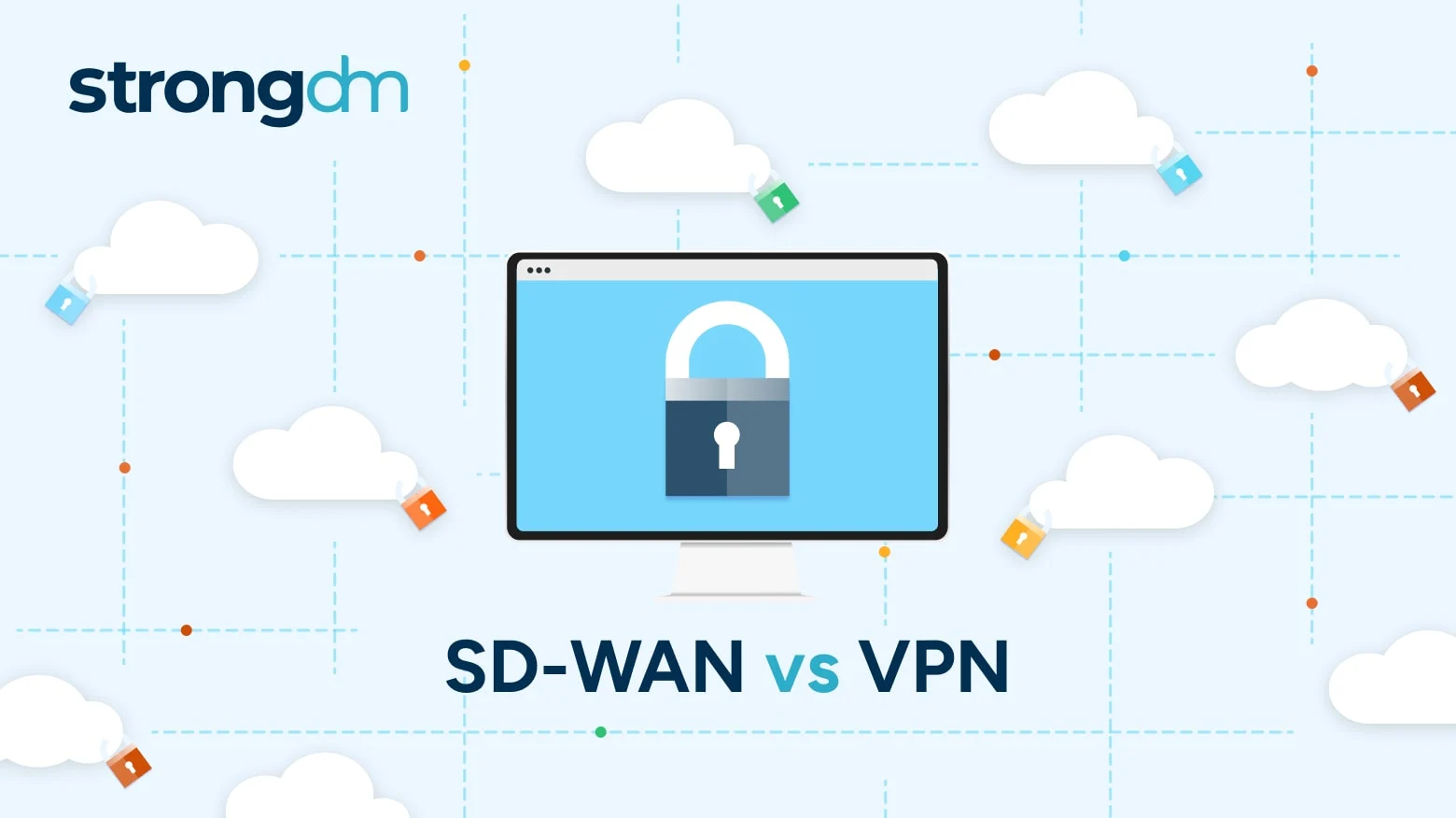SD-WAN vs. VPN: All You Need to Know


Written by
Schuyler BrownLast updated on:
June 26, 2025Reading time:
Contents
Built for Security. Loved by Devs.
- Free Trial — No Credit Card Needed
- Full Access to All Features
- Trusted by the Fortune 100, early startups, and everyone in between
Summary: Thinking about upgrading to SD-WAN? Networking decisions can be challenging, and no one wants to make a costly mistake. The information in this article will help you understand how SD-WAN and VPN compare, so you can decide which option fits your organization best. You can find a networking solution that provides your employees with a secure internet connection while meeting your business needs and budget.
What Are SD-WAN and VPN?
Software-defined Wide Area Network
Software-Defined Wide Area Network (SD-WAN) is a networking technology used to simplify the management of wide area networks (WANs). More secure than traditional WAN solutions, SD-WAN has evolved to meet the needs of the cloud.
Enterprises use SD-WAN to connect users, applications, and data across multiple locations and vast distances. SD-WAN gives organizations centralized control of their WANs and provides visibility over the entire network while offering scalability, reliability, and high performance.
SD-WAN provides real-time monitoring and management of WAN connections and traffic, enabling optimizations to ensure high speed and connectivity. Granular controls allow IT administrators to restrict traffic by type or user.
Although SD-WAN technology is relatively new, adoption is growing rapidly as demand for mobility and remote work increases.
Experts predict the global SD-WAN market to grow from $3.4 billion in 2022 to $13.7 billion by 2027.
Virtual Private Network
VPN (Virtual Private Network) is a service that creates a safe, private connection between an individual device and a network—or between two networks—across an insecure medium, such as the public internet. Companies often use VPNs to enable network access for remote workers.
Fundamentally, a VPN extends a private network across a public one. VPN servers enable users to send and receive data securely over a public network while appearing as if their devices are directly connected to a private network. VPNs use an encrypted tunnel to establish a virtual point-to-point connection between the user’s device and a public network.
The demand for VPN technology is growing rapidly, driven by the explosive adoption of smartphones and wireless devices.
The global VPN market is expected to exceed $76.59 billion by 2030, registering a Compound Annual Growth Rate (CAGR) of 15.42% between 2022 and 2030.
What's the Difference Between SD-WAN and VPN?
SD-WAN acts as a gateway to a network and optimizes the routing of traffic over multiple connections. In contrast, VPN provides point-to-point connectivity between a device and a network (or between two networks) and sends traffic over a single network link.
Simply put, there are two primary differences between SD-WAN and VPN:
- Network architecture—Determines how the connection is implemented
- Transport media—Determines how the traffic flows through connections
Although SD-WAN and VPN work differently, they have the same goal: to facilitate secure access to a network from a remote location. Both provide an encrypted connection plus security features.
Here’s how SD-WAN and VPN compare in terms of security, performance, and cost.
Security
VPN has strong encryption capabilities and can offer smaller businesses significant benefits; however, it carries security risks. VPNs are vulnerable to attacks because they depend on the public internet. If security is improperly implemented, the entire network becomes exposed. Common VPN-related security threats include credential theft, identity theft, the spread of malware from remote users’ devices to the internal network, and risks associated with split tunneling.
With SD-WAN, businesses can enable secure end-to-end encryption across an entire network instead of securing individual connections manually. SD-WAN authenticates all devices at each endpoint within a network. Although specific SD- features vary depending on the provider, SD-WAN solutions offer more security capabilities than VPN—for example, traffic encryption, URL filtering, firewalls, and network segmentation.
Enterprises seeking to adopt an even more robust network security posture may want to consider SASE—a cloud-based service that combines SD-WAN capabilities with security features.
Performance
VPN’s reliance on the public internet makes it vulnerable to internet-related performance issues. For example, spikes in traffic can degrade connection time, and traffic traveling long distances can introduce latency.
Cloud-based SD-WAN eliminates the latency issues that occur when traffic has to travel a long distance. It also includes various performance optimization features that VPN lacks—for example, dynamic path selection, application-aware routing, and Quality of Service (QoS).
Cost
VPN pricing is typically straightforward and affordable. Although prices vary by provider and depend on which features an organization chooses, a business VPN typically costs about $10 per month for each user, not including the cost of a private gateway. Some providers calculate costs based on the number of connection hours and the amount of data transferred instead.
Larger enterprises that can’t get by with a simple VPN solution have two options:
- Build a do-it-yourself in-house SD-WAN
- Choose an SD-WAN solution offered by a managed service provider (MSP)
In-house deployment can be more costly, as businesses typically need to make a significant upfront investment and then need to replace aging infrastructure continuously. That said, SD-WAN delivers immediate benefits that can offset costs.
While most enterprises that deploy a fully integrated SD-WAN solution can expect 100% ROI within 3 years, some will achieve that result after 1 year.
How Are SD-WAN and VPN Similar?
SD-WAN and VPN both provide a secure, encrypted network connection that enables remote access. Both solutions are also internet based.
Although SD-WAN and VPN both connect users to a network, they do so in very different ways. Aside from sharing the same goal, the two solutions are as distinct as apples and oranges. Each has a unique purpose, and the features and use cases associated with each are markedly different.
Unlike VPN, which relies on only one path, SD-WAN has many paths to choose from when routing traffic. SD-WAN provides more flexibility because it can manage multiple types of connections, including MPLS, broadband, 4G, and Long Term Evolution (LTE). This capability enables SD-WAN to optimize routing by directing traffic to the most efficient path in real time.
While VPN can provide a secure, encrypted internet connection for remote employees, it lacks SD-WAN’s monitoring and management capabilities. Consequently, VPN users are more likely to encounter low bandwidth, latency, and other performance issues.
SD-WAN or VPN: Which One Is Right for You?
Besides comparing features when evaluating SD-WAN vs. VPN, organizations must also consider cost, complexity, geography, and interoperability.
VPN
- Has only one path for routing traffic
- Offers a basic solution that anyone can afford
- Can be a good choice for small businesses that need a simple WAN
- Gets the job done, but can be vulnerable to performance issues
SD-WAN
- Has multiple paths for routing traffic, as well as multiple connections
- Offers a better option for large enterprises, particularly if they’re geographically dispersed and rely on the cloud
- Provides the intelligence, visibility, scalability, reliability, performance, and agility today’s organizations need to stay competitive
- Requires underlay network component upgrades when deployed in-house
- Costs more than legacy WAN, but managed SD-WAN solutions can reduce the total cost of ownership (TCO) over time by eliminating in-house building and maintenance
How StrongDM Simplifies Securing Remote Access
The network edge is becoming more complex as cloud adoption, mobility services, and remote work continue to grow. Rapid advancements can be overwhelming. It’s not surprising that most organizations are struggling to keep up with all the changes as technology continues to progress.
To stay agile, companies are increasingly turning to digital transformation to meet the demands of today’s ever-evolving business and IT landscapes.
Modern networking solutions like SD-WAN are superior to VPNs and legacy WANs in many ways. Besides providing more comprehensive security, SD-WAN offers scalability, flexibility, and visibility while delivering better performance and a high-quality user experience—regardless of where people are located when they connect.
Want to know more? Learn how StrongDM can help address VPN security gaps or schedule a demo.
SD-WAN vs. VPN: Frequently Asked Questions
Is SD-WAN better than VPN?
Overall, SD-WAN offers more comprehensive security and better performance than VPN. SD-WAN is also more reliable, as it includes a security feature that automatically repairs a service failure by transferring an IP address to another network. Perhaps most importantly, SD-WAN is scalable whereas VPN is not.
SD-WAN also provides a more seamless experience for business users because it minimizes packet loss, which degrades performance.
Does SD-WAN use VPN?
SD-WAN supports any type of network connectivity, including VPN. Typically, enterprises use SD-WAN to centralize the management of a geographically dispersed network. VPN can be used to connect individual remote workers to the organization’s network.
Can SD-WAN replace VPN entirely?
SD-WAN is far more comprehensive than VPN and can easily replace it. When deciding whether to replace VPN, organizations should consider processes, applications, and overall business strategy. Requiring better performance, migrating to the cloud, and needing to support remote networks are examples of reasons why a business might consider adopting SD-WAN.
In what situations is it better to use SD-WAN instead of VPN?
SD-WAN is better for use cases that aim to transform a business by providing greater flexibility and granular control of network traffic. Whereas a VPN only provides a single connection, SD-WAN offers a way to consolidate all connections, users, and applications and manage access from a single platform.
Next Steps
StrongDM unifies access management across databases, servers, clusters, and more—for IT, security, and DevOps teams.
- Learn how StrongDM works
- Book a personalized demo
- Start your free StrongDM trial

Categories:

About the Author
Schuyler Brown, Chairman of the Board, began working with startups as one of the first employees at Cross Commerce Media. Since then, he has worked at the venture capital firms DFJ Gotham and High Peaks Venture Partners. He is also the host of Founders@Fail and author of Inc.com's "Failing Forward" column, where he interviews veteran entrepreneurs about the bumps, bruises, and reality of life in the startup trenches. His leadership philosophy: be humble enough to realize you don’t know everything and curious enough to want to learn more. He holds a B.A. and M.B.A. from Columbia University. To contact Schuyler, visit him on LinkedIn.
You May Also Like




